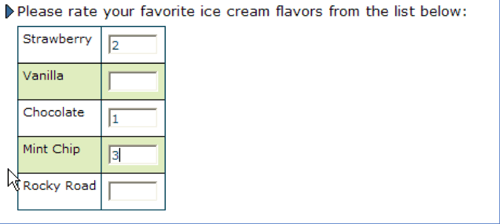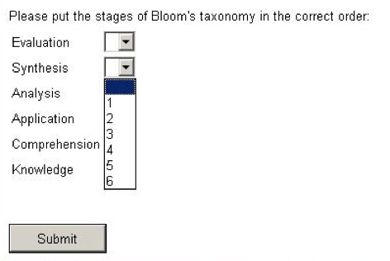What are Sorting Questions?
Sorting questions are often referred to as Ranking or Ordering questions. Sorting questions can be of several types. Some ask the learners to compare a list of items to each other. Some help test learners on principles such as classifications. Some gauge their ability to organize their thoughts into lists based on hierarchy or sequence.
Below is an example of a sorting question. You might like all the flavors of ice cream. But if we ask you to rank them in the order of your preference – highest to lowest, then how would you do it? This question coaxes the respondent to compare each flavor and place them in order of their liking.

Another example of sorting question is given below. Here are a list of French leaders. You have to ask the respondents to sort them from the ancient to the recent one.

When to Use Sorting Questions?
Sorting questions can help you make informed business decisions. Let’s say you are the owner of a restaurant. You have the budget for giving the restaurant a much-needed makeover. You, also, want to enhance the customer experience. You have a lot of new ideas that you wish to implement. But it is not possible to execute all the ideas in the first phase. So, which ones should you choose? This is where sorting or ranking techniques can help. You can start by presenting all the ideas to your customers and then ask them to rank in order of their preference – from high to low. That way, you know which ones are important from the end-user perspective.
Here is another example of using sorting questions. Suppose, you create a course on Bloom’s Taxonomy and at the end of it you wish to test the learner’s knowledge of sequence. You could ask them to order the stages in the correct sequence.

Are Ranking and Rating Questions Same?
No, absolutely not. It may sound same but you need to understand the underlying difference between the two in order to use them to their best potential. Ranking questions compare different items to each other. The respondents are asked to rank the options in their order of preference. Rating questions are interested in gauging how the respondents feel about a particular option. They measure positive or negative vibes on a Likert scale.
Tips To Successful Sorting Questions
Sorting questions are valuable tools to get quality feedback from the respondents. But, they take extra effort from the participants. So, use them wisely. Also, make sure that the options have been chosen with utmost care. You would not want them to rank/sort ideas that will be of no value to you. So, word your questions and answer options judiciously.
Try and limit the options to a maximum of 10 items. Generally, respondents are good at pointing out a few things they really like and a few they really dislike. So, the rankings will be reliable for the top and bottom three options. The middle ones make be skewed. For example, in a list of ten options, the difference between the 4th and 5th rank may not be too strong or reliable. Avoid reading too much into it.
If you have a large list of items that you need to be ranked, the best practice is to categorize it into four or five categories and divide the options into these five categories. That way, the respondents do not need to go through a never-ending list of options and rank them. Ranking or sorting questions may need more time to analyze, but they provide nuanced results. You can expect to draw clear patterns from the data.
You can easily create courseware and using these microlearning design tips using MyEcontentFactory. Our authoring tool allows you to import content, media, and assessments, make real-time changes and collaborate with your colleagues.

.jpg)




Leave a comment